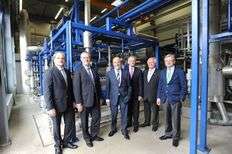- The joint venture invested EUR 5.3 million in the plant, which began construction in March 2013 and was commissioned in November 2013.
- The plant purifies and liquefies CO2, a byproduct of vinyl acetate production, achieving purities of up to 99.999%.
- The facility produces 3.4 tons of CO2 per hour, totaling roughly 28,000 tons annually.
- The plant uses 20% less energy than estimated, consuming around five gigawatt-hours of electricity per year.

Investment and Timeline
The joint venture, consisting of four mid-sized German gas producers, invested EUR 5.3 million in the new CO2 production plant at Industriepark Höchst. Construction began in March 2013, and the plant was commissioned in November 2013.
Plant Operations
The facility, located on a 1,300 square meter lot, purifies and liquefies CO2, a byproduct of vinyl acetate production from neighboring Celanese Chemicals Europe GmbH. The plant achieves CO2 purities of up to 99.999%, meeting high industry standards.
Production Capacity
The plant produces 3.4 tons of CO2 per hour, amounting to approximately 28,000 tons annually. The CO2 is cooled to -25°C and stored in three high-level tanks, each with a capacity of 100 tons. A tank truck loading point allows for easy transportation to customers.
Energy Efficiency
The plant is highly energy-efficient, using around 20% less energy than initially estimated. It consumes about five gigawatt-hours of electricity per year, qualifying it as an energy-intensive operation under the German Renewable Energy Act (EEG).
Environmental Impact
By recycling CO2 from vinyl acetate production, the plant significantly reduces emissions and transforms waste into a valuable commodity. This integration benefits both the environment and the production processes at Industriepark Höchst.

